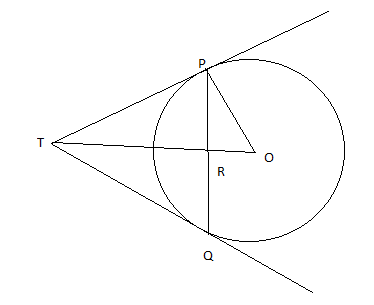Answer
414.6k+ views
Hint: In order to solve this question we have to apply the concept of Pythagoras theorem.
According to Pythagoras theorem, the square of the hypotenuse side is equal to the sum of the squares of the other two sides in a right-angled triangle.
By using the concept, we get the values
Finally we get the required answer.
Formula used: $Bas{e^2} + Perpendicula{r^2} = Hypotenus{e^2}$
Complete step-by-step answer:
It is stated in the question that the length of the chord $PQ$ is $8$$cm$ and the radius of the circle, that is , $OP = 5cm$
From the above diagram in $\vartriangle TPO$ and $\vartriangle PRO$ we get-
$\angle TPO = \angle PRO$ since both are right angles
$\angle OTP = \angle RPO$
So $\vartriangle TPO$ and $\vartriangle PRO$ are similar.
Therefore, $\dfrac{{TP}}{{PR}} = \dfrac{{OP}}{{OR}}$…..$(i)$
Since we have $PQ = 8cm$ therefore $PR = 4cm$ as the chord $PQ$ is bisected by $OT$ and also $OP = 5cm$
By applying Pythagoras theorem in $\vartriangle POR$ we can write-
$P{R^2} + O{R^2} = O{P^2}$
Now, putting the values of $PR$ and $OP$ we get-
$\Rightarrow$${4^2} + O{R^2} = {5^2}$
Taking the find value as LHS and remaining as RHS, we get
$\Rightarrow$$O{R^2} = 25 - 16$
On subtracting we get,
$\Rightarrow$$O{R^2} = 9$
Taking square root on both sides we get,
So, $OR = \sqrt 9 = 3$
Now, substituting the values of $PR,OP,OR$ in equation $(i)$ we get-
$\Rightarrow$$\dfrac{{TP}}{4} = \dfrac{5}{3}$
So, $TP = \dfrac{{20}}{3}$
It is further given in the question that length of $TP$$ = \dfrac{a}{3}$
Therefore we can write that-
$\Rightarrow$$TP = \dfrac{a}{3} = \dfrac{{20}}{3}$
So,$\dfrac{a}{3} = \dfrac{{20}}{3}$
By doing cross-multiplication we get-
$\Rightarrow$$3a = 60$
On dividing $3$ on both side we get
$\Rightarrow$$a = \dfrac{{60}}{3} = 20$
Hence the value of $a$ is $20$
Note: Tangent is a straight line which touches the circle only at a particular point.
Point of tangency can be defined as the point where the tangent meets the circle.
The tangent is always perpendicular to the circle at the point of tangency.
It cannot touch the circle at two different points.
From an exterior point, the lengths of the tangents to the circle are equal.
The formula for finding out the tangent to the circle is
$\dfrac{{PR}}{{PS}} = \dfrac{{PS}}{{PQ}}$
According to Pythagoras theorem, the square of the hypotenuse side is equal to the sum of the squares of the other two sides in a right-angled triangle.
By using the concept, we get the values
Finally we get the required answer.
Formula used: $Bas{e^2} + Perpendicula{r^2} = Hypotenus{e^2}$
Complete step-by-step answer:
It is stated in the question that the length of the chord $PQ$ is $8$$cm$ and the radius of the circle, that is , $OP = 5cm$
From the above diagram in $\vartriangle TPO$ and $\vartriangle PRO$ we get-
$\angle TPO = \angle PRO$ since both are right angles
$\angle OTP = \angle RPO$
So $\vartriangle TPO$ and $\vartriangle PRO$ are similar.
Therefore, $\dfrac{{TP}}{{PR}} = \dfrac{{OP}}{{OR}}$…..$(i)$
Since we have $PQ = 8cm$ therefore $PR = 4cm$ as the chord $PQ$ is bisected by $OT$ and also $OP = 5cm$
By applying Pythagoras theorem in $\vartriangle POR$ we can write-
$P{R^2} + O{R^2} = O{P^2}$
Now, putting the values of $PR$ and $OP$ we get-
$\Rightarrow$${4^2} + O{R^2} = {5^2}$
Taking the find value as LHS and remaining as RHS, we get
$\Rightarrow$$O{R^2} = 25 - 16$
On subtracting we get,
$\Rightarrow$$O{R^2} = 9$
Taking square root on both sides we get,
So, $OR = \sqrt 9 = 3$
Now, substituting the values of $PR,OP,OR$ in equation $(i)$ we get-
$\Rightarrow$$\dfrac{{TP}}{4} = \dfrac{5}{3}$
So, $TP = \dfrac{{20}}{3}$
It is further given in the question that length of $TP$$ = \dfrac{a}{3}$
Therefore we can write that-
$\Rightarrow$$TP = \dfrac{a}{3} = \dfrac{{20}}{3}$
So,$\dfrac{a}{3} = \dfrac{{20}}{3}$
By doing cross-multiplication we get-
$\Rightarrow$$3a = 60$
On dividing $3$ on both side we get
$\Rightarrow$$a = \dfrac{{60}}{3} = 20$
Hence the value of $a$ is $20$
Note: Tangent is a straight line which touches the circle only at a particular point.
Point of tangency can be defined as the point where the tangent meets the circle.
The tangent is always perpendicular to the circle at the point of tangency.
It cannot touch the circle at two different points.
From an exterior point, the lengths of the tangents to the circle are equal.
The formula for finding out the tangent to the circle is
$\dfrac{{PR}}{{PS}} = \dfrac{{PS}}{{PQ}}$
Recently Updated Pages
How many sigma and pi bonds are present in HCequiv class 11 chemistry CBSE

Why Are Noble Gases NonReactive class 11 chemistry CBSE

Let X and Y be the sets of all positive divisors of class 11 maths CBSE

Let x and y be 2 real numbers which satisfy the equations class 11 maths CBSE

Let x 4log 2sqrt 9k 1 + 7 and y dfrac132log 2sqrt5 class 11 maths CBSE

Let x22ax+b20 and x22bx+a20 be two equations Then the class 11 maths CBSE

Trending doubts
Fill the blanks with the suitable prepositions 1 The class 9 english CBSE

At which age domestication of animals started A Neolithic class 11 social science CBSE

Which are the Top 10 Largest Countries of the World?

Give 10 examples for herbs , shrubs , climbers , creepers

Difference between Prokaryotic cell and Eukaryotic class 11 biology CBSE

Difference Between Plant Cell and Animal Cell

Write a letter to the principal requesting him to grant class 10 english CBSE

Change the following sentences into negative and interrogative class 10 english CBSE

Fill in the blanks A 1 lakh ten thousand B 1 million class 9 maths CBSE




